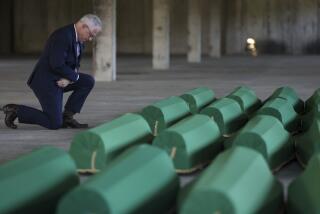Victim, Victimizer Testify to Horrors of Bosnia War
- Share via
THE HAGUE — In a riveting day of testimony Friday, the international war crimes tribunal here heard from both victimizer and victim in the disastrous fall of the Bosnian city of Srebrenica: one man who said he personally gunned down about 70 Muslim men and boys as they tried to flee the doomed U.N. “safe area,” and another who said he survived his own execution when falling bodies knocked him out of the way of a firing squad’s bullets.
The survivor, a peasant farmer introduced only as Witness A, gave the tribunal a powerful, extemporaneous account of three days of organized shooting and bludgeoning, in which he repeatedly placed the Bosnian Serb army chief, Gen. Ratko Mladic, in a commanding role at the scene of the roundups and killings.
The farmer’s testimony painted Mladic as an obsessive angel of death, a man who appeared again and again--at holding centers, beside buses and at the sites of the killings themselves.
The testimony of Witness A covered the events of July 11-13, 1995, beginning on the day Srebrenica was overrun by Bosnian Serb forces. More than 6,000 Bosnian Muslim men have been missing since the city fell in what appears to have been the bloodiest single incident of the 3 1/2-year war in Bosnia-Herzegovina.
Prosecutors with the tribunal hope to show the court that Mladic and his civilian boss, Bosnian Serb leader Radovan Karadzic, were directly responsible for these and other Muslim deaths and that their orchestrating roles amounted to genocide.
Witness A testified that he saw Mladic six times over the three days as he was being herded around with a group that eventually totaled about 2,500 Muslims.
Twice, he said, Mladic directed a grimly portentous question at the amassed prisoners: “What am I going to do with you? Your government doesn’t want you, and I have to take care of you.”
By the end of the third day, Witness A said, all but he and one other man from the 2,500 had been killed.
The robust tones of Witness A, who spoke from inside a booth so that no one could see his face, contrasted with the halting, agonized speech of the other witness, Drazen Erdemovic, a 24-year-old who served with the Bosnian Serb army and who had already appeared once before the tribunal--as a defendant.
On Friday, Erdemovic’s arm twitched as he spoke. He fidgeted in his seat. He kept closing his eyes. And, at the end, he broke down in tears.
A spokesman for the tribunal announced Thursday that Erdemovic’s trial--a separate proceeding--will be postponed at least until October because psychiatrists say he is suffering from post-traumatic stress syndrome.
Erdemovic said he saw Mladic only once in the chaotic days after Srebrenica fell, briefly, and didn’t hear him give any commands. Most of his testimony was about the firing-squad executions he said he helped carry out at a collective farm.
Erdemovic said he and three others in his unit rebelled when asked later to travel to another execution site: “I said that I didn’t wish to kill anyone, that I was no robot for the extermination of people.”
Later, he said, a fellow soldier shot him in the stomach, evidently because he “had reached the conclusion that I might do what I’m doing today--that is, testify.”
The leitmotif in Witness A’s rapid-fire testimony, by contrast, was Mladic, who he said showed up repeatedly and assured the prisoners that their roundup was innocuous--that they were needed merely for use in an upcoming prisoner exchange.
But finally, Witness A said, he was taken by truck to a field already covered with bodies. His group was ordered down from the truck, lined up and shot. Witness A said that the men behind him fell on top of him, knocking him to the ground and saving his life.
From beneath the growing pile of bodies, Witness A said, he watched Bosnian Serb soldiers walking around, finishing off the wounded. More trucks arrived, and their passengers were also shot. Then a red car pulled up.
“Ratko Mladic came out,” the witness said. “Ratko Mladic watched as people were being forced out of the truck and lined up. Ratko Mladic stood and watched until all the people had been killed and were silent. Then he returned to his small car.”
Friday’s testimony was the high point so far of hearings in which war crimes prosecutors are trying to persuade the tribunal to formally brand Mladic and Karadzic “international fugitives,” subject to arrest by any state.
The evidence heard up until Friday had already placed Mladic in a command role for the capture of Srebrenica, but Witness A provided by far the most damning report of the general’s personal involvement.
The case against Karadzic, by contrast, is of a more general nature, based on descriptions of the way he built up local political and military structures that later committed brutal “ethnic cleansing.”
On Friday, two lawyers from Southern California also appeared, saying that they had been empowered by Karadzic to represent him before the tribunal. Edward Medvene of Los Angeles and Thomas Hanley of Marina del Rey said they wanted to appear before the hearing because, Medvene said, “We do not believe there has been any attempt to serve Dr. Karadzic” with his indictment.
The three-judge panel granted the two lawyers “observer status.” That merely meant they could sit in the visitors gallery, which they did.
More to Read
Sign up for Essential California
The most important California stories and recommendations in your inbox every morning.
You may occasionally receive promotional content from the Los Angeles Times.













